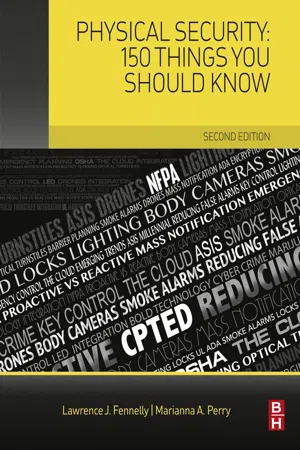2. Effective Physical Security
Someone has to question design, development, and event planning decisions. Do you think that anyone from the police department or fire department for that matter asked the builder of a major hotel in Kansas City whether they had extra steel reinforcing rods left over when they built the cross-bridge that fell and resulted in many deaths and injuries? Did anyone ask the planners how the downtown pedestrian malls would respond when the “Flash Mob” fad swept the country in early 2000–16? No! Major planning mistakes were made then and continue to be made because no one is asking the right questions.
• People: Will always be the number one aspect in security. Their motivation and training make it work.
• Policy/procedure: Allows for easy enforcement.
• Hardware: Must be state of the art and highly reliable.
• Facilities: Although each complex may look different in shape and design, the principles and concepts are the same.
• Information: Proactive responses and documentation are needed.
• Human resources department: A critical area, especially when the termination of an employee is to take place. For example, access cards will need to be disabled and ID badges need to be returned/recovered along with any keys to mechanical locks.
3. Site and Target Hardening
Some factors to consider when hardening a site or facility include:
1. Layered security or defense in depth—a single protection approach is not effective, but instead a series of levels that complement each other are needed.3
a. The ASIS security glossary (2006) defines layered security as, “a physical security approach that requires a criminal to penetrate or overcome a series of security layers before reaching the target. The layers might be perimeter barriers, building or area protection with locks, CCTV and guards’ and point and trap protection using safes, vaults, and sensors.”4
2. Standoff distance—the distance between a critical asset and the nearest point of attack.
a. The Department of Homeland Security has designed a standard standoff distance chart to protect critical assets, such as buildings and areas, from the effects of a bomb blast.5
3. Structural integrity of the premises—against attacks and natural disasters.
a. Structural integrity can be assessed to determine how reliable a structure is to be able to withstand day-to-day activities as well as natural and man-made disasters.
4. Redundancy of operation systems—such as power; heating, ventilation, and air conditioning (HVAC); and communications systems.
a. Have backup systems that are in place and tested to endure operability.
Sample recommendations are as follows:
• The HVAC exterior intakes should be protected to prevent the introduction of harmful materials into the intake systems. Some buildings place air intakes high above the ground or on the roof, whereas others use physical barriers to prevent unauthorized access to the air intakes. Intrusion detection devices, video surveillance, and/or security officers may be utilized.
• Air intakes exhaust and ventilation openings greater than 10 in. in diameter should be secured and/or monitored to prevent unauthorized access to or the introduction of a biological agent into the building.6
• It should be ensured that there is no subterranean access to buildings through underground utility openings such as water intakes, sewers, vents, or ducts. Any opening larger than 96 in. should be protected with welded bar grills. An alternative to one large pipe with access into the facility is the construction of multiple pipes, each having a diameter of less than 10 in. but with the same capacity as the one large pipe.6
• It should be ensured that there is no access to buildings through roof-mounted air returns, ventilation louvers, or maintenance hatches.
Additionally, we have 10 items listed below to consider as part of your physical security program:
1. Use effective lockdown procedures and products.
2. Make window glazing impact and bullet resistant.
3. Improve access control with appropriate visitor screening.
4. Identify sexual predators.
5. Stay current on real-time crime and local incident data.
6. Utilize duress alarms for additional immediate response.
7. Use mass notification tools like beacons, digital signage, public address systems, and electronic device alerts.
8. Maximize entry/exit door security.
9. Utilize internet protocol (IP) cameras with effective storage capabilities.
10. Expedite response time of emergency response personnel.
